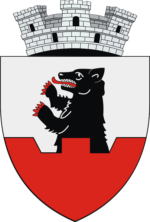Szentágota

Szentágota (Agnita, Agnetheln, Ongenîtlen) is a town in Transylvania, in Romania. It is famous for the fortified church built by the German Saxons of Transylvania. Szentágota is 37 km from the town of Medgyes (Medias) to the southeast. The Saxons settled there before the first Mongolian invasion of 1241.

Enjoy the video (if you speak German):
https://www.youtube.com/watch?v=nBWihA5Iruk
There is an interesting thing: the Hortobágy River flows across the settlement, it has the same name as the famous field that is located in Hungary.

The first document mentioning it is a land sale contract signed in 1280 by one Henric from Sancta Agatha. Later, it was mentioned as Vallis Sancte Agnetis (1317), Scenthagata (1349), and Zenth Ágotha (1601). Its Romanian name derives from the German name of the place. In 1376, King Lajos (Louis) I of Hungary granted the village the right to hold a market on each Saint Ivan Day. Since that time, it has been a market town for 600 years. In the Middle Ages, the town had the right to hold three national markets a year.

The church has three naves that were built around the year 1409. Later, it was strengthened, and the church has undergone many transformations. The four towers of the fortified church – the shoemakers, tailors, blacksmiths, and coopers – demonstrate the economic strength of these guilds, and were assigned to the defense of those portions of the wall in case of armed conflict. City Museum has a substantial collection of medieval art (Gothic chests, architecture, sculpture, ceramics, etc.).

Governor Hunyadi János spent a night there on 15 August 1448 and gave orders to reinforce the town because of the Ottoman threat. (Please, note that I use the Oriental name order for Hungarians where family names come first.) In 1466, it was King Matthias Corvinus who gave the village the right to conduct trials and the “jus gladi”, the right to decide and execute the death sentence. In the same year, the village was allowed to keep half of the contingent of royal troops to defend their own city since it was near the frontier toward Wallachia. Also, King Matthias helped the inhabitants to build a wall around the church to defend the Kingdom of Hungary against the Ottoman Empire.

We know that there were 953 inhabitants in Szentágotas in 1488, and it was regarded as a rather large settlement in the region. There were nine priests, a schoolmaster, and two scribes among them. The small settlements got rich because there was a junction of roads to the Barcaság region and the Valley of the Küküllő River.

It was a town populated by traditional craftsmen, famous for the old guilds of tanners, shoemakers, tailors, coopers, and potters, with a semi-rural economy. We know the rules of the Tailors’ Guild from 1524. There were 42 tailors in it in 1666. Also, there was a significant Lutheran school until the end of the 16th century. The town has one of the oldest peasant fortifications in Transylvania. The first church was built in the thirteenth century, then it was continuously enlarged until the seventeenth century, and three fortified enclosures with towers were added to it. In 1560, it was ready but it burned down in 1600.

Unfortunately, the two outer rings of walls were pulled down between 1845 and 1870. However, four towers were not demolished: the Coopers’ Tower (Fassbinderturm, ‘Kádárok tornya’) that stands on the northern side, supplied with an iron gate; the Taylors’ Tower (Schneiderturm, ‘Szabók tornya’) is on the southeastern side; the Tower of the Smiths (Schmiedturm, ‘Kovácsok tornya’) is on the east; the Tanners’ Tower (Schusterturm, ‘Vargák tornya’) is on the southwestern side. There was a defensive wall above the sanctuary of the church that was demolished in 1892.

As for its population, in 1900 3940 inhabitants were living there, 2565 Saxons, 847 Romanians, 329 Gypsies (Roma people), and 161 Hungarians. In 2002, there were 8997 inhabitants, 8386 Romanians, 329 Hungarians, 139 Saxons, and 133 Gypsies (Roma people).
Dear Readers, I can only make this content available through small donations or by selling my books or T-shirts.
If you like my writings, please feel free to support me with a coffee here:
You can check out my books on Amazon or Draft2Digital, they are available in hardcover, paperback, or ebook:
https://www.amazon.com/dp/198020490X or at https://books2read.com/b/boYd81

My work can also be followed and supported on Patreon: Become a Patron!http://Become a Patron!

https://hungarianottomanwars.myspreadshop.com/all
































